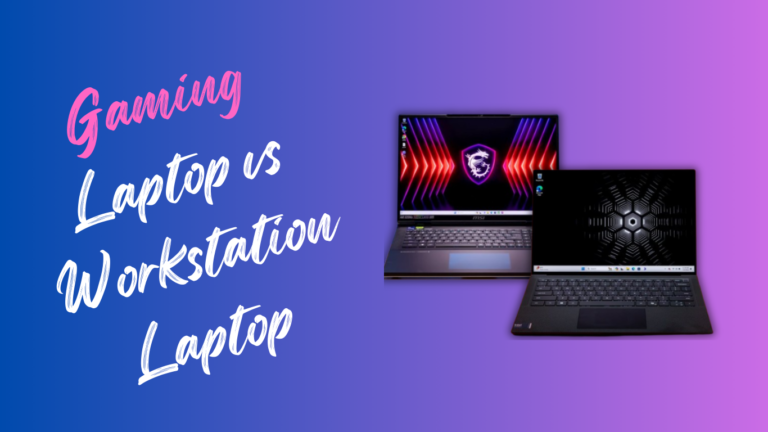Understanding the Difference
Gaming laptops are high-performance devices optimized for real-time rendering, fast refresh rates, and GPU-intensive tasks. Workstation laptops focus on professional applications, offering precision computing, high-end CPUs, and ECC memory.
Users:
- Gaming Laptops: Gamers, streamers, and casual content creators.
- Workstation Laptops: Engineers, designers, and professionals in 3D modeling, AI, and data science.
Gaming laptops prioritize speed and visuals, while workstation laptops ensure stability and accuracy for complex computations.
Performance Comparison: Power vs. Precision
Gaming laptops use high-clock-speed CPUs like Intel Core i9-14900HX or AMD Ryzen 9 7945HX for fast processing. For multi-core performance and stability, workstation laptops feature Intel Xeon or AMD Ryzen Threadripper CPUs. Gaming GPUs, such as NVIDIA GeForce RTX 4090, prioritize real-time rendering and high frame rates.
Workstation GPUs, like NVIDIA RTX A6000, support ray tracing, CUDA cores, and optimized drivers for professional software. Gaming laptops use 16GB to 32GB DDR5 RAM for speed. Workstation laptops include ECC RAM up to 128GB for data accuracy. Storage varies, with gaming models using NVMe SSDs and workstations favoring high-capacity PCIe Gen 4 SSDs.
Display & Graphics: High Refresh Rate vs. Color Accuracy
Gaming laptops use high-refresh-rate displays, such as 240Hz or 360Hz, for smooth gameplay. Panels with low response times, like 1ms, reduce motion blur. OLED and IPS screens improve contrast and viewing angles.
Workstation laptops prioritize color accuracy with 100% sRGB, AdobeRGB, or DCI-P3 coverage. Factory-calibrated displays support precise color grading. HDR10 and Dolby Vision enhance dynamic range.
Gaming laptops favor Full HD or QHD resolutions for performance. Workstations use 4K or 8K displays for high-detail workflows. Mini LED and True Black panels improve brightness and depth perception.
Build Quality & Design: Aesthetic vs. Durability
Gaming laptops feature aggressive styling, RGB lighting, and angular chassis. Brands like ASUS ROG and Alienware use customizable LED accents and bold designs. Magnesium alloy or aluminum builds improve durability. Workstation laptops prioritize a professional, minimalistic design.
Lenovo ThinkPad and Dell Precision models use reinforced aluminum or carbon fiber for durability. MIL-STD-810G certification ensures resistance to shocks and temperature variations. Gaming models have larger vents for cooling, while workstations focus on compact, thermally efficient designs. Hinges on workstations support 180-degree rotation for flexible usage.
Software Compatibility: Gaming vs. Professional Applications
Gaming laptops optimize performance for DirectX 12, Vulkan, and OpenGL-based games. Models like ASUS ROG Strix Scar 18 and MSI Titan GT77 support high FPS and ray tracing with NVIDIA RTX 4090. Workstation laptops prioritize stability for AutoCAD, Adobe Suite, and 3D rendering. Lenovo ThinkPad P1 and Dell Precision 7780 use NVIDIA RTX A5000 GPUs and ECC RAM for precision computing. Gaming models excel in fast processing but lack ISV-certified drivers. Workstations feature Quadro or Radeon Pro GPUs with optimized drivers for professional applications.
Battery Life & Portability: Which One Lasts Longer?
Gaming laptops consume more power due to high-performance CPUs and GPUs. Models like ASUS ROG Strix Scar 18 use 330W adapters and drain batteries faster under load. Workstation laptops prioritize efficiency with optimized power consumption. Dell Precision 7780 and Lenovo ThinkPad P1 feature lower TDP components, extending battery life. Gaming models last 3-5 hours on battery with high-refresh displays. Workstations with energy-efficient processors and larger batteries, like 99Wh, offer up to 10 hours.
Price & Value for Money: Which One is Worth It?
Gaming laptops cost between $1,200 and $4,000, depending on specs. High-end models like Alienware x17 and Razer Blade 16 include RTX 4090 GPUs and Intel Core i9 processors. Workstation laptops are more expensive, ranging from $2,000 to $6,000. Devices like Dell Precision 7780 and HP ZBook Fury 16 offer Xeon CPUs, Quadro RTX GPUs, and ECC memory. Gaming laptops provide better price-to-performance for casual users. Workstations deliver long-term value for professionals with certified software optimization and durability.
Future Trends: What to Expect in 2025 and Beyond
AI-powered performance optimizations enhance real-time rendering and workload management. Intel Lunar Lake and AMD Strix Point processors integrate AI acceleration for efficiency. Evolving GPU technologies focus on ray tracing, upscaling, and power efficiency. NVIDIA RTX 50 series and AMD RDNA 4 improve gaming and professional workloads. Quantum dot and microLED displays offer higher brightness and color accuracy. PCIe 5.0 and LPDDR6 memory increase bandwidth and multitasking speeds.
Conclusion: Making the Right Choice
Selecting the right laptop depends on user needs and workloads. Gaming laptops prioritize high refresh rates, powerful GPUs, and RGB aesthetics. Workstation laptops focus on durability, color accuracy, and professional software compatibility. Battery life favors workstation models with optimized power efficiency. Gaming laptops consume more power due to high-performance components. Price varies based on features, with workstations offering long-term stability. Future trends include AI performance enhancements, advanced cooling, and improved GPU efficiency.
Frequently Asked Questions (FAQs)
What is the main difference between gaming and workstation laptops?
Gaming laptops prioritize high refresh rates, powerful GPUs, and aggressive designs. Workstation laptops focus on durability, color accuracy, and professional software compatibility.
Which laptop type has better battery life?
Workstation laptops offer better battery efficiency due to optimized power management. Gaming laptops consume more power due to high-performance hardware.
Are gaming laptops suitable for professional work?
Gaming laptops can handle professional software but lack color accuracy and thermal efficiency required for prolonged workloads.
Do workstation laptops support gaming?
Workstation laptops can run games but lack high refresh rates and gaming-optimized GPUs, leading to lower performance in fast-paced titles.
Which laptop is a better long-term investment?
Workstation laptops provide long-term stability with durable designs and software optimizations. Gaming laptops may require frequent upgrades for peak performance.
What are the future trends in laptop technology?
AI-driven optimizations, advanced cooling solutions, and evolving CPU & GPU architectures will shape future gaming and workstation laptops.

